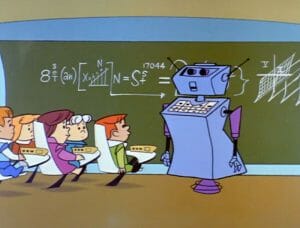
Articles
Editor’s Picks
Educational Robotics: Impacts on eLearning
By Cait Etherington
January 24, 2018
As 2018 kicks off, educational robots have already received considerable attention, but will 2018 be remembered as the year of the robot and if so, how will these robots impact education and more specifically, eLearning?
What are Educational Robots?

Educational robots may not be what you think…at least not yet. To date, most educational robots don’t have limbs, faces, or wander around interacting with students. Indeed, so far, we have yet to come even close to developing the sort of teacher robot that staffed the Litter Dipper School on the 1960s’ cartoon, The Jetsons. In fact, our speculations about what robots, including educational robots, would look like has not been realized at all. In 2018, most robots, at least educational robots, continue to take less human-like forms, such as balls, blobs and strange hexagons that spin around on the table or floor. Despite all these limitations, however, little by little robots are arriving in our homes and classrooms.
Consider, for example, the Dot by Wonder Workshop. The Dot looks like a large eye trapped in a green ball, but this doesn’t mean that the Dot can’t interact with humans. In fact, the Dot, which has been designed for elementary-school-age children, can have conservations, encourage physical activity, and even play dress up (yes, the Dot comes with various “costumes” and stickers so if you’re not happy hanging out with an eye trapped in a plain green ball, you can dress up your Dot as you please). But Wonder Workshop is not a lone player in the educational robotics market. Cytron Technologie, LEGO, Makebloc, Modular Robotic, and ROBOTIS are also emerging as key players.
Educational Robots and eLearning

So far, the most obvious link between the growing trend in educational robots and eLearning is the possible impact of “telepresence robots.” which is generally understood to refer to a robot that is both mobile and uses video technologies to recognize and communicate with individuals in the real world.
Given these limitations, the Wirecutter suggests that telepresence robots are likely not yet ready for primetime and may be more of a novelty than technology about to transform people’s lives. The high price tag of telepresence robots (currently running around $4000 per unit) and the fact that they currently look like a iPad attached to a carpet sweeper from the 1970s is also likely to limit their potential market. That said, there is the possibility that moving forward, telepresence robots might be able to roam around interacting with students and in a sense, bring a more teacherly style of interaction to the distance education context. For now, however, the current interface shift from screen-based to voice-activated forms of eLearning (e.g., with the arrival of devices at Alexa) appear more likely to transform learning on site and at a distance.
The Future of Educational Robots
While it may be too soon to predict what’s next for educational robots, there are certainly signs that the market is growing. A recently released Technavio report on the global reconfigurable educational robots market found that K-12 and higher education solutions dominated the market in 2017 and that this trend will continue over the next year. There are also promising signs that educational robots may have an especially profound impact on certain groups of students who have traditionally been marginalized in the school system, including those with autism and other types of disabilities. Still, for now, there are no signs that human teachers are about to be immediately replaced in on-premise or online programs. In fact, at least for now, educational robots appear to be emerging as potentially helpful teacher aids but not as stand-alone teachers.









No Comments